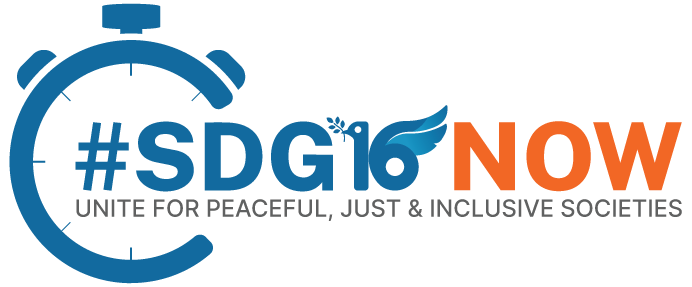The UN Sustainable Development Goals (SDGs) represent humanity’s most ambitious blueprint to create a just, peaceful and inclusive world. In 2015, the international community adopted the SDGs, which featured the ground-breaking inclusion of SDG16+, outlining ambitious commitments towards fostering peace, good governance, accountability, and human rights that need to be addressed to ensure that sustainable development, and the SDGs, are effective, successful and reach all persons. SDG16 is interlinked in hundreds of ways with other SDGs and is key to the overall success of SDGs.
As we reach the halfway point of Agenda 2030, there are some reasons for hope but many more causes for concern. As UN Secretary-General António Guterres has outlined in the 2023 Special Edition of the SDGs Progress Report, the SDGs are off track, with most unlikely to reach their 2030 targets. SDG16 is among the least successful – all of the targets are off track, with a sizeable number even regressing. Many were already lagging, and the compounding effects of the conflict in Ukraine and the COVID-19 pandemic have hindered progress even further.
Currently, of the 12 SDG16 targets, none are likely to be achieved by 2030. Only two of the SDG16 targets – birth registration and national human rights institutions – are showing signs of progress, with a handful of indicators in other targets also showing positive but inadequate progress. Five targets, related to peace and violence, children, rule of law and access to justice, fundamental freedoms, and discrimination, are regressing; of particular concern is the declining progress in achieving peace-related objectives. The remaining five targets have changed little since their adoption.
The absence of advancements and the regression in achieving SDG16+ not only casts doubt on the effectiveness of the SDGs, but also carries tangible repercussions for individuals worldwide. In 2023, an estimated 339 million people will need humanitarian assistance and protection globally — the highest figure in decades.1 Killings of human rights defenders have been increasing substantially since the 2030 Agenda was adopted, with 401 human rights defenders killed in 26 countries in 2022.2 Globally, it is estimated that approximately one billion children between the ages of 2 and 17 – half of all children in the world – experience physical, emotional or sexual violence every year, with this trend moving in the wrong direction.3
This report, which reflects the analysis of hundreds of civil society, UN, and government stakeholders from across the world, substantiates these concerns that progress towards SDG16+ has been slow and uneven, and in many cases backsliding. Around 60 per cent of respondents from our global-constituent survey felt there was backsliding or little progress on SDG16+, both internationally and domestically. A majority felt that governments engaged with Civil Society Organisations (CSOs) at (Voluntary National Reviews (VNRs), but much less so outside of that process. The biggest challenges were funding, accountability and transparency, lack of data and lack of inclusivity with regards to marginalised communities.
All of these problems highlight the need for civil society to play a larger role in promoting SDG16. Civil society already plays a crucial role in SDG16 implementation; many of the best sources of information on progress of SDG16 are produced by civil society and academic institutions, with citizen-generated data being especially important to show impact at the local level. Spotlight reporting highlights the gaps in the official reporting and should be more formally incorporated within official processes. Positively, more countries appear to be expanding out, formally including civil society and others in their reviews, even if somewhat superficially at present. At the same time, limits on civic space and growing authoritarianism are making it harder for civil society to effectively operate.
As we approach the halfway point of Agenda 2030, and in light of the forthcoming 2023 SDG Summit, now is the time for governments, UN bodies, and other stakeholders to make changes, to seriously incorporate SDG16 into national laws, to involve civil society, and to promote inclusive processes. The High-Level Political Forum (HLPF) should conduct a detailed review of SDG16 every year and better examine how the interlinkages are working. Governments should be forthcoming in their reviews and data collections on their progresses and deficits.
The 2023 SDGs Summit presents a crucial opportunity for governments and the international community to align SDG16+ action and implementation towards 2030. To make significant progress, governments must bring concrete and transformative commitments to SDG16+ to the SDGs Summit. These commitments should outline clear, verifiable, and quantifiable actions that demonstrate how governments will fulfill their existing obligations under SDG16+. In addition, civil society should be included at all stages of the commitment-making process to ensure people-centered and responsive commitments are made that address the needs of citizens.
Adequate financing is essential for the successful realisation of SDG16+ and the overall 2030 Agenda. Governments and the international community must come to the 2023 SDGs Summit with transformative financial commitments. This includes national commitments to domestic resource mobilisation and budgetary allocations, as well as financial commitments from donors towards SDG16+. Moreover, reforming the international financial architecture is necessary to address structural barriers and ensure long-term financing for sustainable development.
Accountability for SDG16+ and the 2030 Agenda is essential, and commitments made at the 2023 SDGs Summit must be compiled and tracked transparently. The UN Secretariat should establish a web-based platform, possibly utilising the UN SDG Actions Platform, to feature these commitments and facilitate verification. Additionally, the HLPF should be reformed to provide an action-oriented platform for commitments and accountability. This requires raising the level of ambition for the HLPF through the planned review of HLPF in 2024, and integrating commitments and forward-looking actions towards the SDGs into its preparation, programme and follow-up.
